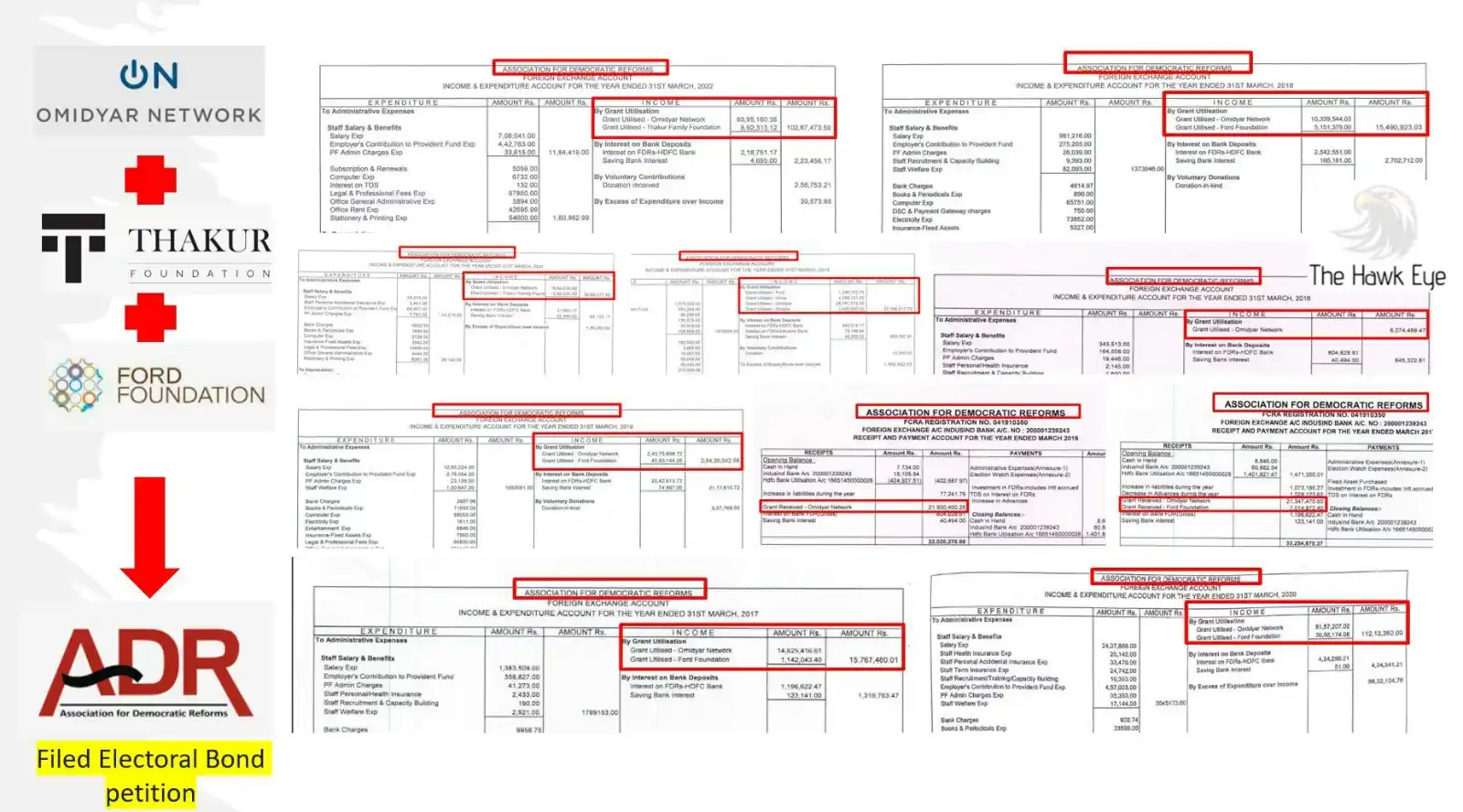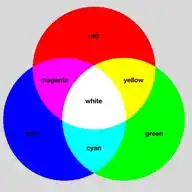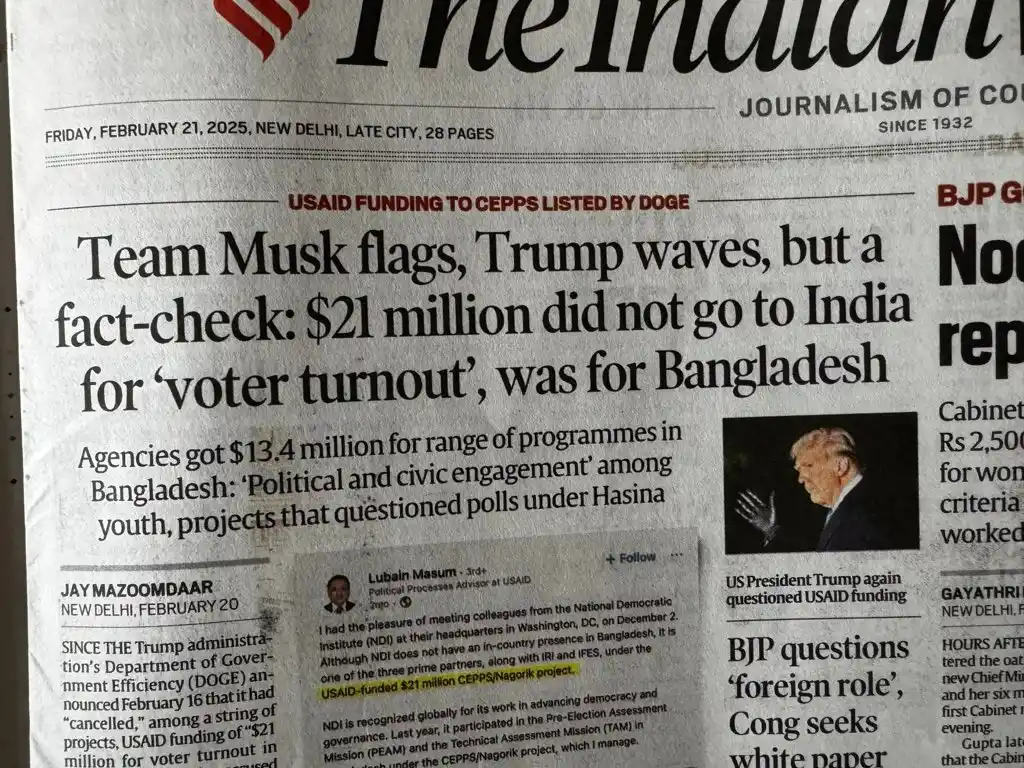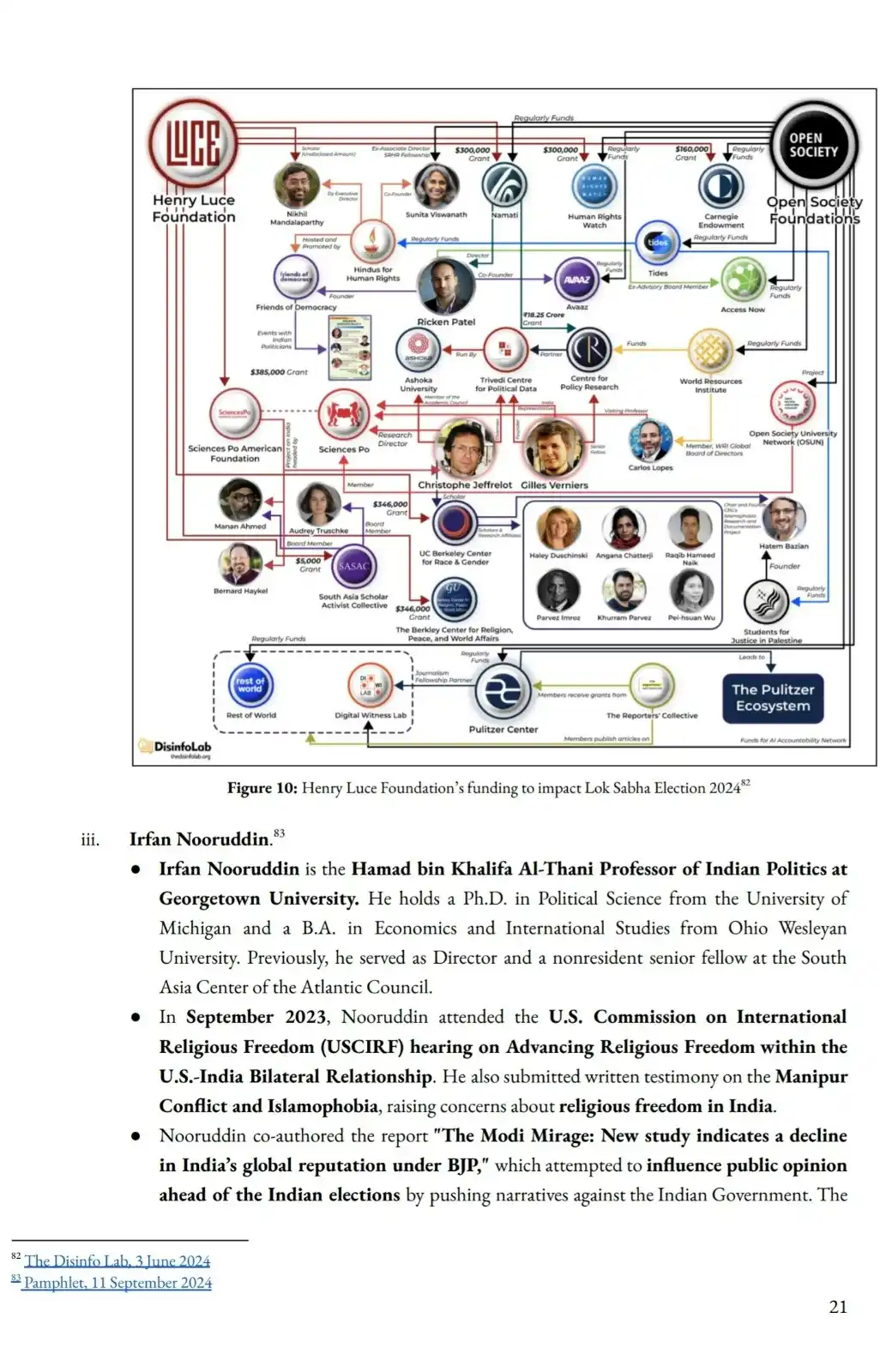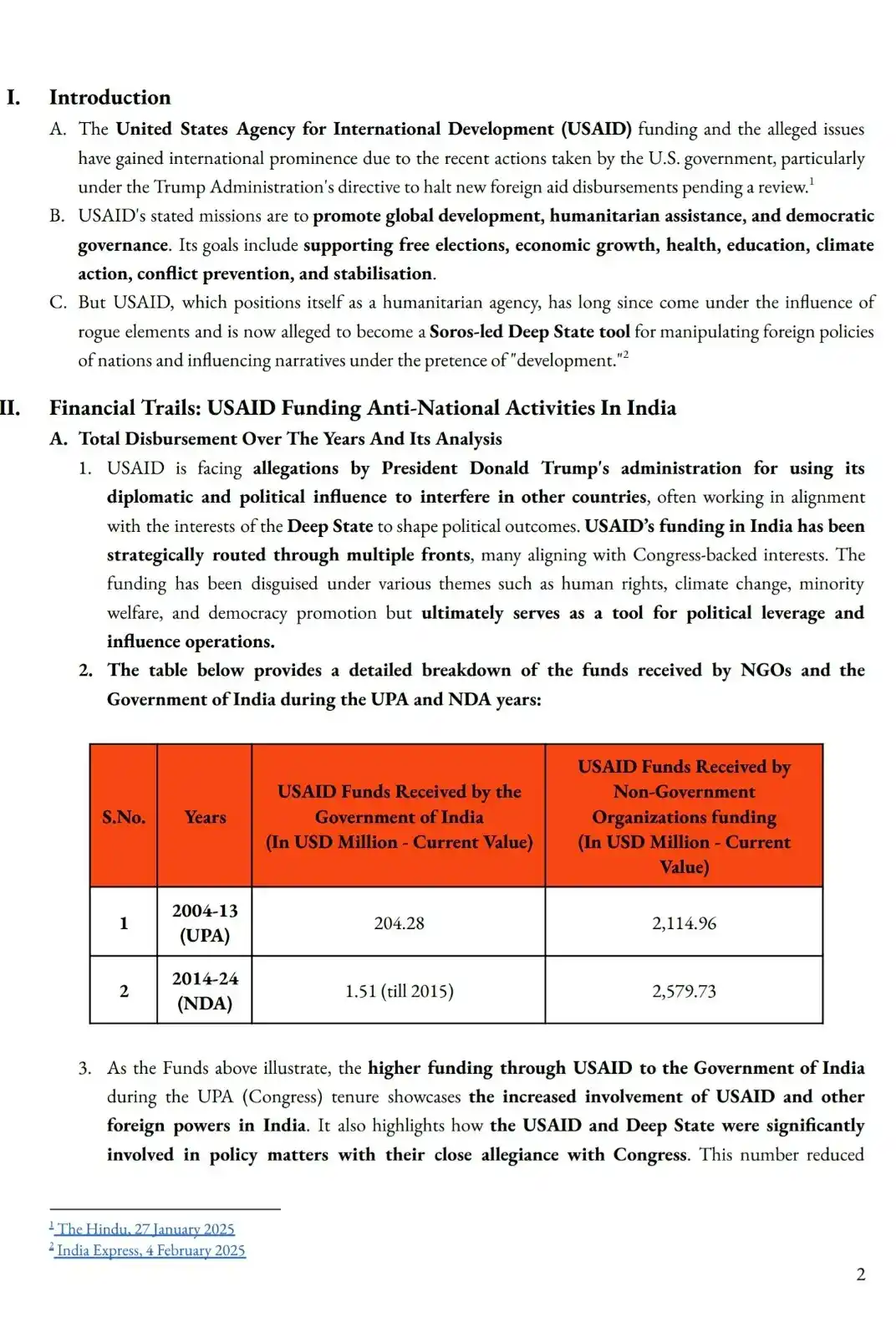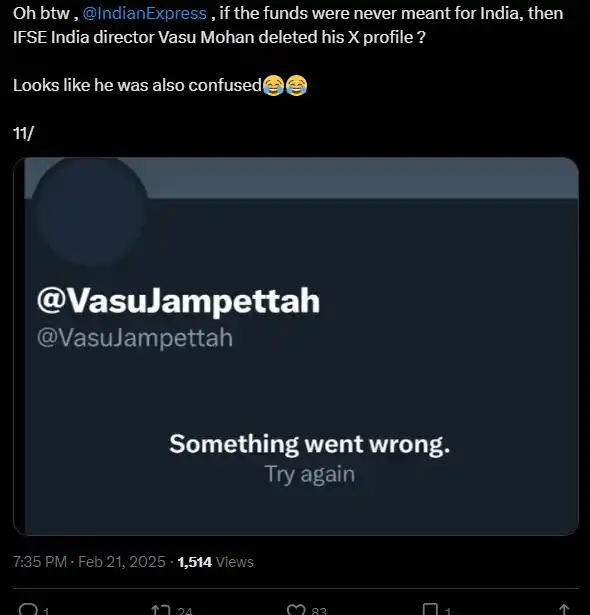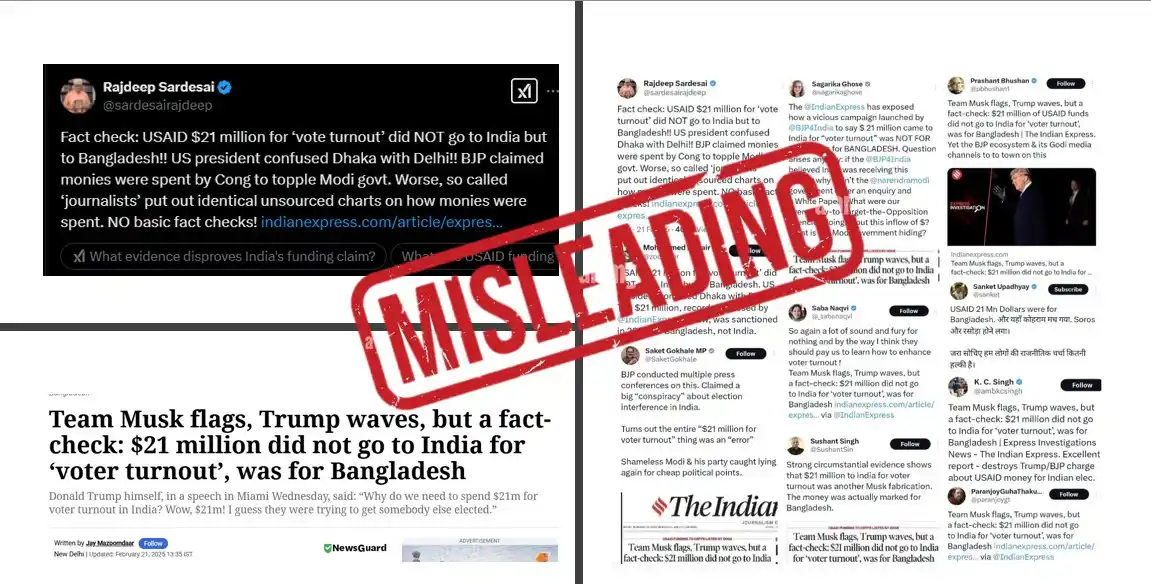
B.Pratap
8 subscribers
About B.Pratap
As a Data Analyst | Political, Geopolitical, War, Ethics, Education, Governance, Judiciary, Law & Order, Social Media, Spirituality, Religion & Research | Evidence-Based Critical Analysis of Social Welfare & Issues
Similar Channels
Swipe to see more
Posts

Unmasking the Truth: The $21 Million USAID Controversy and Media Misdirection in India In a stunning revelation that has sent shockwaves through India’s political and media landscape, recent allegations of foreign interference in Indian elections have exposed a tangled web of funding, misinformation, and institutional ties. At the heart of the controversy is a claim that the United States Agency for International Development (USAID), through its partner organizations like the Consortium for Elections and Political Process Strengthening (CEPPS), funneled $21 million into India to influence voter turnout during general elections. This amount, reportedly canceled by the U.S. Department of Government Efficiency (DOGE) under the leadership of Elon Musk and President Donald Trump, has sparked intense debate. However, a prominent Indian newspaper, known for its left-leaning editorial stance, has published reports attempting to dismiss these allegations as a mere confusion with Bangladesh, where $29 million was allegedly allocated for similar purposes. This narrative, however, unravels under scrutiny, revealing a pattern of media misdirection aimed at protecting a broader ecosystem of liberal-leaning news anchors, NGOs, and foreign-funded entities. The controversy erupted when U.S. President Donald Trump repeatedly highlighted the $21 million USAID funding, explicitly stating it was intended for India, not Bangladesh, and even alleging bribes were involved to maintain “deep-state assets” that deflect such revelations. DOGE’s cancellation of the funds, announced in early 2025, confirmed the allocation was for India, targeting voter turnout programs—a move critics argue could sway electoral outcomes. Yet, a major Indian daily, with a history of favoring liberal causes, rushed to publish a fact-check article claiming the funds were never meant for India but were instead part of a $21 million grant for Bangladesh’s “Amar Vote Amar” project, later renamed the “Nagorik (Citizen) Program.” This assertion conveniently ignored Trump’s clear differentiation between the $21 million for India and the $29 million for Bangladesh, as well as DOGE’s explicit documentation of the canceled Indian funding. This media response appears to be part of a coordinated effort to shield a network of liberal-leaning journalists, news anchors, and NGOs from scrutiny. The newspaper’s claim that no USAID-funded CEPPS project has existed in India since 2008 is easily debunked by historical evidence: in 2013, the U.S. State Department sanctioned $500,000 for CEPPS in India, managed by USAID, coinciding with the 2014 Indian general elections. Further, annual disbursements of approximately $320,000 from 2016 to 2019, along with a staggering $11.6 million from the National Democratic Institute (NDI) between 2022 and 2024, and $11.5 million from the International Foundation for Electoral Systems (IFES) between 2003 and 2008, paint a picture of sustained foreign financial involvement. These funds, channeled through CEPPS’s fronts—IFES, NDI, and the International Republican Institute (IRI)—suggest a decades-long pattern, with a total USAID investment in India reaching an estimated $2.9 billion, allegedly sustaining a deep-state network of media, NGOs, and activists. The newspaper’s narrative falters further when examined alongside suspicious digital activity. Both CEPPS’s website and X account have been deactivated, and Vasu Mohan, the IFES India director with over two decades of experience, deleted his X profile amid the controversy. If the funds were truly unrelated to India, as claimed, why would key figures and organizations erase their online presence? This pattern of concealment extends to a 2012 Memorandum of Understanding (MoU) between India’s Election Commission of India (ECI) and IFES, signed under then-Chief Election Commissioner S.Y. Quraishi, who later received an IFES award in 2014. This MoU facilitated data exchange and joint initiatives, raising concerns about foreign access to India’s electoral data, potentially enabling targeted influence campaigns. The media’s rush to defend this narrative appears motivated by a need to protect its own ecosystem. Liberal-leaning news anchors and journalists, often critical of the current Indian government, have long relied on foreign-funded NGOs and think tanks for resources and narratives. The newspaper’s fact-check, laden with loaded language and poor sourcing, aligns with its left-center bias, as documented by independent media watchdogs, which rate it as having mixed factual reporting due to failed fact-checks and editorial positions favoring liberal causes. By dismissing Trump’s and DOGE’s claims as “confusion,” the outlet inadvertently exposes its role in a broader strategy to deflect scrutiny from a network that benefits from USAID funding, including figures tied to George Soros’s Open Society Foundation and other international donors. This pattern mirrors global concerns about foreign interference, with Trump’s allegations of bribes and Musk’s characterization of USAID as a “criminal organization” resonating in India. The Modi government’s tightening of Foreign Contribution Regulation Act (FCRA) rules and monitoring of over 20,000 foreign-funded NGOs suggest an awareness of these risks, contrasting sharply with the media’s apparent reluctance to investigate. The newspaper’s defense of the status quo—claiming no interference exists—ignores the historical and ongoing financial trails, as well as the panicked digital deletions by implicated organizations and individuals. In conclusion, the $21 million USAID funding controversy reveals a troubling intersection of foreign influence, media bias, and institutional complicity in India. While the newspaper seeks to provide relief to its liberal-leaning anchors by publishing false reports, the evidence—historical funding, canceled grants, institutional ties, and digital cover-ups—tells a different story. The $21 million for India, distinct from the $29 million for Bangladesh, underscores a deliberate attempt at electoral manipulation, now exposed by U.S. policy shifts and independent scrutiny. This narrative battle highlights the urgent need for transparency and accountability to safeguard India’s democratic integrity from external pressures and internal apologists, urging the public to question one-sided media narratives and demand a thorough investigation into the true extent of foreign influence in Indian elections.


*Omidyar Network’s Influence in India: A Deep Dive into Funding, Politics, and Controversy* In recent years, Omidyar Network, founded by eBay billionaire Pierre Omidyar, has emerged as a significant yet controversial player in India’s socio-political and media landscape. The organization’s activities—spanning funding for startups, NGOs, and media outlets, as well as its alleged role in political advocacy—have sparked intense debate, particularly with its 2025 partnership with The Indian Express and its involvement in the electoral bonds controversy. As Omidyar Network officially ceased operations in India on December 31, 2024, amid regulatory crackdowns, a comprehensive analysis of its threads—revealed through detailed X posts by The Hawk Eye, including a key post from February 21, 2025 (https://x.com/thehawkeyex/status/1892971487910383922)—offers critical insights into its sophisticated operations and their far-reaching implications. *A Global Player with a Local Impact* Omidyar Network, established in 2004, began its foray into India in 2011, positioning itself as a “philanthropic investment firm” with a dual structure: the Omidyar Network Fund (a grantmaking nonprofit) and an impact investment arm. Its stated mission includes supporting education, emerging technologies, financial inclusion, and property rights. However, its investments—totaling over Rs 3,000 crore in more than 100 Indian companies—extend far beyond traditional philanthropy, raising concerns about data access and influence over millions of lives. The Hawk Eye’s thread, starting with a post on May 15, 2022 (https://x.com/thehawkeyex/status/1525846697254866944), highlights Omidyar’s global strategy, referencing its alleged role in the 2014 Euromaidan protests in Ukraine. The thread claims that Omidyar funded groups opposing the pro-Russia government, contributing to its eventual ousting through digital media and advocacy. This pattern, The Hawk Eye suggests, mirrors Omidyar’s approach in India, where it has invested in a “sustainable ecosystem” rather than just direct beneficiaries, including media outlets like News Laundry, Scroll, and The Ken. *The FCRA Bribery Scandal and Regulatory Scrutiny* The controversy deepened in May 2022 when the Central Bureau of Investigation (CBI) busted an illegal Foreign Contribution Regulation Act (FCRA) clearance bribe racket. According to The Hawk Eye’s thread, Omidyar Network India’s promoters were implicated, alongside 36 individuals, including six government officials from the Ministry of Home Affairs’ FCRA division and an official from the National Informatics Centre. The CBI alleged that bribes were exchanged to secure FCRA licenses, with transactions worth around Rs 2 crore uncovered through hawala channels. This scandal underscored the risks of foreign-funded NGOs influencing Indian policy and governance, prompting the Ministry of Home Affairs to place Omidyar on the FCRA watchlist in September 2021. The regulatory crackdown on foreign-funded organizations under Prime Minister Narendra Modi’s administration, which The Hawk Eye notes banned over 16,000 NGOs for FCRA violations between 2015 and 2019, reflects broader concerns about national security and political stability. Omidyar’s eventual exit from India by the end of 2024, as stated on its official website, appears to be a strategic retreat amid this scrutiny, though its legacy of influence lingers. *Electoral Bonds and Political Funding Transparency* Omidyar’s footprint in India’s political landscape became particularly visible through its funding of the Association for Democratic Reforms (ADR), a non-governmental organization that played a pivotal role in challenging the Electoral Bonds Scheme. Introduced in the 2017-18 Union Budget by then-Finance Minister Arun Jaitley, the scheme aimed to “cleanse” political funding by allowing anonymous donations to political parties. However, ADR, supported by Omidyar, argued that it increased corporate funding, black money circulation, and corruption, filing petitions that led to the Supreme Court’s landmark February 2024 ruling. The court declared the scheme unconstitutional, ordering the State Bank of India to disclose details of electoral bond purchases from April 12, 2019, onward, revealing funding patterns and intensifying debates about transparency in Indian politics. The Hawk Eye’s post from February 21, 2025 (https://x.com/thehawkeyex/status/1892971487910383922), underscores this connection, noting, “Indian Express is partnering with Omidyar Networks. Let me remind you (right) that ADR, which created electoral bond fuzz, is also funded by Omidyar.” This post ties Omidyar’s funding to both the electoral bonds controversy and its media partnerships, suggesting a coordinated ecosystem influencing public discourse and policy. The Hawk Eye’s threads connect these dots, arguing that Omidyar’s investments in think tanks like the Center for Policy Research (CPR) and NGOs like the Commonwealth Human Rights Initiative (CHRI)—which shares executives with the Indian Police Foundation (IPF)—create a “complex maze” of influence over policy-making. This ecosystem, the thread contends, enables Omidyar to indirectly shape Indian governance, even as it distances itself from direct political advocacy. *Media Influence and The Indian Express Partnership* The recent partnership between Omidyar Network and The Indian Express, announced in early 2025 and focused on digital innovation and public interest journalism, has raised significant questions about potential editorial influence. While the collaboration aims to enhance journalistic standards, The Hawk Eye’s analysis suggests that Omidyar’s funding of media outlets like News Laundry and Scroll indicates a broader strategy to shape public discourse. The February 2025 post by The Hawk Eye explicitly flags this partnership, warning that Omidyar’s involvement could extend its influence over mainstream media narratives, especially given its funding of ADR and its role in the electoral bonds case. This convergence of media, NGOs, and political advocacy has fueled concerns about foreign entities influencing India’s democratic processes, especially given Omidyar’s alleged ties to left-leaning causes and its sophisticated operational model. *National Security Concerns and the Exit from India* The Hawk Eye’s threads, spanning multiple posts from 2022 to 2025, emphasize the national security implications of Omidyar’s activities. By investing in digital startups, think tanks, and NGOs, Omidyar gained access to vast amounts of private data and policy influence, potentially aligning Indian interests with foreign agendas. The CBI’s 2022 investigation and the MHA’s regulatory actions reflect a growing wariness of such networks, which The Hawk Eye compares to other foreign-funded entities like the Ford Foundation and George Soros’ Open Society Foundations. Omidyar Network’s cessation of operations in India by December 31, 2024, as confirmed by its website and reported in Business Standard, marks the end of an era but not the end of the debate. The organization’s legacy—marked by innovation, controversy, and influence—leaves behind questions about the balance between foreign funding, national sovereignty, and democratic integrity. The Hawk Eye’s February 2025 post notes this exit, tying it to the broader context of tightened FCRA regulations and investigations into foreign-funded NGOs, including Omidyar’s past involvement in the bribery scandal. *Conclusion* Omidyar Network’s journey in India, as detailed in The Hawk Eye’s threads, reveals a sophisticated player in the global philanthropy and investment space, with a footprint that extends from startups to media, NGOs, and political advocacy. While its contributions to digital innovation and social causes are notable, the allegations of bribery, political influence, and national security risks have cast a shadow over its operations. The 2025 partnership with The Indian Express, combined with its role in the electoral bonds controversy via ADR, underscores the organization’s deep entanglement in India’s democratic processes. As India continues to tighten regulations on foreign funding, Omidyar’s exit serves as a cautionary tale about the complexities of international philanthropy in a geopolitically sensitive context. The Hawk Eye’s posts not only connect these dots but also underscore the need for vigilance in safeguarding India’s democratic institutions and public discourse, ensuring that foreign influence does not undermine national sovereignty or media independence.
